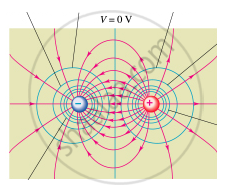Advertisements
Advertisements
प्रश्न
Draw the equipotential surfaces due to an electric dipole. Locate the points where the potential due to the dipole is zero.
उत्तर
Equipotential surface due to electric dipole:

The potential due to the dipole is zero at the line bisecting the dipole length.
APPEARS IN
संबंधित प्रश्न
Describe schematically the equipotential surfaces corresponding to
(a) a constant electric field in the z-direction,
(b) a field that uniformly increases in magnitude but remains in a constant (say, z) direction,
(c) a single positive charge at the origin, and
(d) a uniform grid consisting of long equally spaced parallel charged wires in a plane.
The top of the atmosphere is at about 400 kV with respect to the surface of the earth, corresponding to an electric field that decreases with altitude. Near the surface of the earth, the field is about 100 Vm−1. Why then do we not get an electric shock as we step out of our house into the open? (Assume the house to be a steel cage so there is no field inside!)
What is the geometrical shape of equipotential surfaces due to a single isolated charge?
Define equipotential surface.
Depict the equipotential surface due to
(i) an electric dipole,
(ii) two identical positive charges separated by a distance.
Statement - 1: For practical purpose, the earth is used as a reference at zero potential in electrical circuits.
Statement - 2: The electrical potential of a sphere of radius R with charge Q uniformly distributed on the surface is given by `Q/(4piepsilon_0R)`.
The diagrams below show regions of equipotentials.
(i) |
(ii) |
(iii) |
(iv) |
A positive charge is moved from A to B in each diagram.
Can two equipotential surfaces intersect each other?
Find the equation of the equipotentials for an infinite cylinder of radius r0, carrying charge of linear density λ.
What is meant by an equipotential surface?
